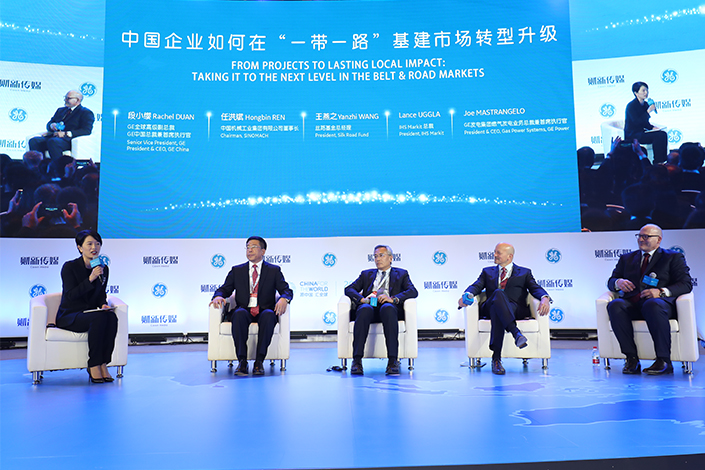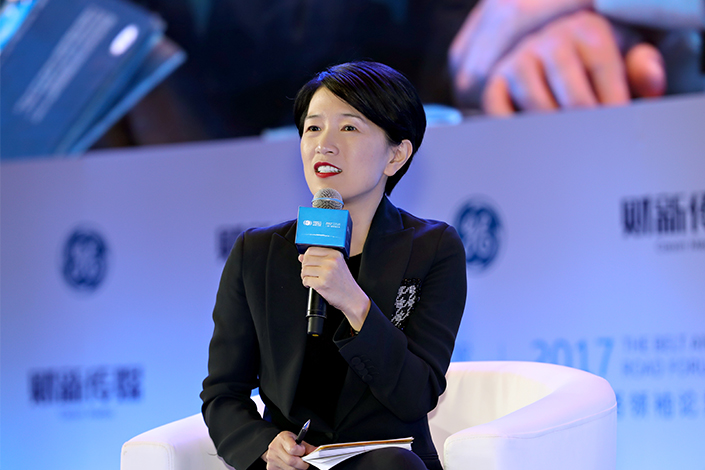GE and Team China Build for the Future along Belt and Road
This year's “China for the World” Belt and Road Forum in Beijing -- a private-sector forum focusing on supporting Chinese infrastructure companies going global in Belt and Road markets -- served in many ways as a global showcase for GE.
Held on November 2 near the Bird’s Nest stadium - the site of the 2008 Beijing Olympics - the one-day event opened with a panel discussion among industry leaders as well as a keynote speech delivered by a former minister of foreign affairs. The morning summit subsequently broke out into focused-topic sessions discussing the Belt and Road initiative’s geographic locations, including Latin America, Africa, the MENAT (Middle East, North Africa and Turkey) region and the ASEAN group of nations. Afternoon sessions featured discussions concerning the business areas of Gas and Steam Power, Renewables and Project Financing.
 |
The EPC Ecosystem
The summit attracted near 800 experts from a cross-section the infrastructure industry ecosystem including Chinese EPC (Engineering, Procurement and Construction) leaders, project end-users, financiers and government officials. Each participant has the potential to play a key role in the EPC “ecosystem” which GE was seeking to foster in the forum.
As Senior Vice President of GE, and President and CEO of GE China Rachel Duan sees it, the company is in a prime position to build such an ecosystem by connecting players from the upper, middle and lower rungs of the industry's value chain, building communication bridges between foreign and Chinese enterprises, and connecting with Chinese policy makers regarding the Belt and Road initiative.
Twenty years ago, GE became one of the first foreign partners for Chinese EPCs. Now, its role has become more involved, as GE has built a variety of a cooperation models with Chinese enterprises. For some companies, GE functions as an equipment supplier, while for others it serves as a financier, joint shareholder, partner, or all of the above.
China's uniquely advantageous position on the world economic stage is incomparable. Among developed countries, the China market cannot be neglected. And among developing countries, China offers an enormous wealth of hard-earned experience as well as technology that can be shared and transferred.
Last May, the Chinese government decided to inject another 100 billion yuan into the Silk Road Fund. This amount, together with an initial US$ 40 billion in capital, helped the Silk Road Fund rise to the status of a dual-currency investment fund.
New Wave of Globalization Led by China
China’s Belt and Road initiative will bring a new wave of globalization, said Rachel Duan. It's also a key motivating factor in encouraging Chinese enterprises to expand abroad.
For some Chinese enterprises, the challenges have proved difficult to overcome. Others, however, have found new ways to cope and succeed.
“As pilots along the Belt and Road, Chinese EPCs are now facing various challenges including international competition, geopolitical risks, financing, and conflicts of culture,” said Hongbin Ren, Chairman of Sinomach, one of China's biggest EPC enterprises. “With the increasing difficulty and complexity of infrastructure projects along the Belt and Road, almost every project requires inter-regional, inter-company, and inter-industry cooperation.”
A typical EPC project may be owned by an African country, tendered and developed by a Chinese company, supplied by equipment from an American company and later re-financed by an American fund. This was the case for GE’s Kenya Kipeto Wind Power plant, for example.
With GE China being led by its first Chinese CEO, the division is ready to take advantage of an historic opportunity.
GE’s Chinese EPC business posted revenues of US$ 400 million in 2010 and US$ 2.3 billion in 2016. It further projects EPC revenues will double by 2020.
But is this revenue projection overly optimistic? Rachel Duan says it is not. Her confidence stems from the fact that more than 1 billion people worldwide are now in dire need of electricity. Most of these people live in countries covered by the Belt and Road initiative. And GE has local offices in 63 out of the initiative's 65 countries. It goes without saying that GE's business potential is huge.
A decade ago, Chinese EPC contracts were financed by state-owned banks, de facto sovereign wealth funds or simply through foreign aid. Today, financing is more often a deal-maker for Chinese EPC enterprises.
Backed by its GE Store and global footprint, GE is now able to further support EPC deals. Out of the US$ 2.3 billion worth of EPC deals for GE in 2016, some US$ 1.38 billion were financed deals. In other words, 60 cents out of every dollar for EPC deals were part of a financed contract. Furthermore, GE is now able to tap China's capital market by forming a strong alliance with Sinosure and the Silk Road Fund.
Meanwhile, on the manufacturing side, GE has long invested in technology and services while building and expanding its manufacturing base in China. GE’s largest hydroelectric power facilities design and manufacturing center is in Tianjin, while its largest boiler design and manufacturing center is in Wuhan. Five years ago in Shanghai, GE joined hands with China Huadian Corporation to build a joint venture called the Huadian-GE Aero Gas Turbine Equipment Co. Ltd., which was considered a major step forward in the localization of its industrial chain.
Some changes have also reflected strategic upgrades for Chinese EPCs, which are today more prominent than ever. After all, 49 of this year's top 250 global contractors, as compiled by Engineering News, were Chinese. GE has partnered with more than 30 of these Chinese companies.
 |
Early Planning, Deeper Engagement
Looking ahead, GE China’s Rachel Duan outlined a three-pronged, comprehensive strategy aimed at steering the GE flagship to greater success. GE’s cooperation with China’s EPCs is slated to deepen through “joint market development, joint financing and joint operation,” she said.
One goal of joint market development is to understand the real needs of local markets. Efforts include dedicated research into each local market’s energy ecosystem and existing infrastructure. The effort calls for actively finding ways to best benefit end-users.
An example of this strategy can be found in the recent tie-up between GE and PowerChina, a leading Chinese EPC and a longtime GE partner. The two companies showcased new efforts in market development by publishing an in-depth market report on Nigeria’s grid system, in response to challenges identified by the two companies in powering the country. The report represents a shift toward more proactive market development efforts to ensure that projects along the Belt and Road not only solve their primary goals of generating power at the source, but also provide a long-sighted view of benefits for end-users and effectively distribute power according to the country’s energy needs.
Similarly, GE, together with China Energy Engineering Corp. (CEEC) recently published a report on the state of the power market in Vietnam. The report was aimed at exploring the new models of resource allocation and cooperation between China EPCs and foreign technology enterprises like GE to enhance market development and identifying opportunities for short- and mid-term projects with co-investment and financing.
Through joint financing, GE will share its global resources and financial talent for Chinese EPC projects. It will support Chinese EPCs to optimize project risk prevention and control mechanisms, allocate global financial resources, and achieve more competitive and differentiated equity investment and debt financing solutions. In terms of joint operation, the company plans to provide its digital capabilities and big data analysis to assist Chinese EPCs with facilities operations and maintenance projects in the future.
Team China
One relationship built on this new strategy is GE’s partnership with PowerChina. Unlike previous EPC+Financing and RFQ-driven models, the GE and PowerChina project alliance calls for early engagement, demand creation and total solution activities, as well as establishing a new model to fully leverage each party's potential in the areas of technology, personnel, EPC execution, operations and maintenance.
The two companies agreed to a strategic design framework to strengthen and expand their longtime global energy ecosystem cooperation, which already covers over 20 countries worldwide. The outcome-oriented three-year plan covers fast track, SPS and grid, as well as renewables including hydro and wind. It is the first such agreement covering all of GE’s energy-related businesses.
It is not difficult to see how effective GE China and its Chinese partners, including financiers and EPCs, have been in forming a strong, Team China platform for Belt and Road.
GE is celebrating its 125th anniversary this year against the backdrop of a dramatic shift – in 2001, 70% of GE’s revenues came from the United States; today, that same percentage is generated outside of the United States. No doubt, GE China accounts for a large proportion of that non-U.S. percentage.
Meanwhile, in countries targeted by the Belt and Road initiative, Team China and GE are moving forward together as global partners.


